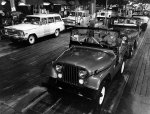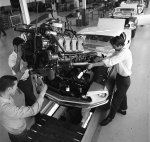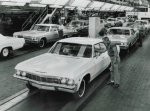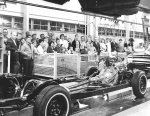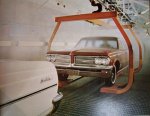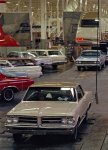You are using an out of date browser. It may not display this or other websites correctly.
You should upgrade or use an alternative browser.
You should upgrade or use an alternative browser.
Assembly Line Photos
- Thread starter MyBigBlockDodge
- Start date
v8440
Well-known member
In that next to last photo, anybody else notice that the body you can see is a buick, but the engine in the chassis right behind it is a pontiac? Maybe they were building similar cars from the 2 brands on the same line? That was well before mixing of engine and car brands began at GM.
Not A Duster
Well-known member
In that next to last photo, anybody else notice that the body you can see is a buick, but the engine in the chassis right behind it is a pontiac? Maybe they were building similar cars from the 2 brands on the same line? That was well before mixing of engine and car brands began at GM.
Yup - wondering about that myself. If I had to guess, maybe it was a staged advertising photo, and the designer picked the elements they thought made for a better image.
MyBigBlockDodge
Screw it. Give me the red AND blue pills.
MyBigBlockDodge
Screw it. Give me the red AND blue pills.
And a few more misc. pics.



Pretty crazy how they shipped Vegas on their nose. Fluids in the car. Special battery with caps off-center to keep the battery acid in, special washer fluid tank placement and a oil baffle in the engine to keep #1 cylinder from filling up with oil, and a tube from the carb to carbon canister for the fuel that drained from the carb. They developed this Vert-a-Pac system with Southern Pacific railroad to increase the number of cars on each railroad car. Used a forklift to open and close each section of the train cars.




Pretty crazy how they shipped Vegas on their nose. Fluids in the car. Special battery with caps off-center to keep the battery acid in, special washer fluid tank placement and a oil baffle in the engine to keep #1 cylinder from filling up with oil, and a tube from the carb to carbon canister for the fuel that drained from the carb. They developed this Vert-a-Pac system with Southern Pacific railroad to increase the number of cars on each railroad car. Used a forklift to open and close each section of the train cars.

Attachments
TheIronSausage
Two brain cells left.. rubbing together for warmth
No matter how you can them, sardines are still gross
MyBigBlockDodge
Screw it. Give me the red AND blue pills.
You don't have to like them all... just sharing because I thought some would enjoy seeing the photos.
TheIronSausage
Two brain cells left.. rubbing together for warmth
Just a joke. I actually think the Vegas were misunderstood. And rusty. Very rusty.
MyBigBlockDodge
Screw it. Give me the red AND blue pills.
No worries. I had a couple of them over the years. One had some rust in the rear quarters (lived in South Dakota). The other really didn't have any rust at all. They did have their share of issues - especially the early one. Lots of overheating and head gasket issues. Pretty fascinating production stuff though. Shipping cars on end is not something that would have crossed my mind lol
Not A Duster
Well-known member
I was high school age when V8 Vega conversions were common. Those things were tons of fun. And not a bad looking little hot rod when done right...
68R/T
I got drunk and swallowed my teeth, now
I was high school age when V8 Vega conversions were common.
I got a ride in a vega with a 350 tri-power & 4-gear in '81. Snotty little thing.
Three weeks later his girlfriend rear-ended me with that same car. :bwuhaha: Put the vega out of commission but I drove away with a small dent in my rust-bucket '68 nova beater.
Jester
In through the Out Door, so She's
Pretty crazy how they shipped Vegas on their nose. Fluids in the car. Special battery with caps off-center to keep the battery acid in, special washer fluid tank placement and a oil baffle in the engine to keep #1 cylinder from filling up with oil, and a tube from the carb to carbon canister for the fuel that drained from the carb. They developed this Vert-a-Pac system with Southern Pacific railroad to increase the number of cars on each railroad car. Used a forklift to open and close each section of the train cars.
View attachment 18967
This picture relates to part of my work life. If that isn't the most ridiculous, yet ingenious method of loading vehicles onto rail cars...
The normal capacity is 10 vehicles per railcar on a bi-level, or 15 (small vehicles) on a tri-level. I count 24 or so Vega(s). Looks like a pain in the arse to load and unload though. Not sure they saved much $$, if any at all, using this method.






